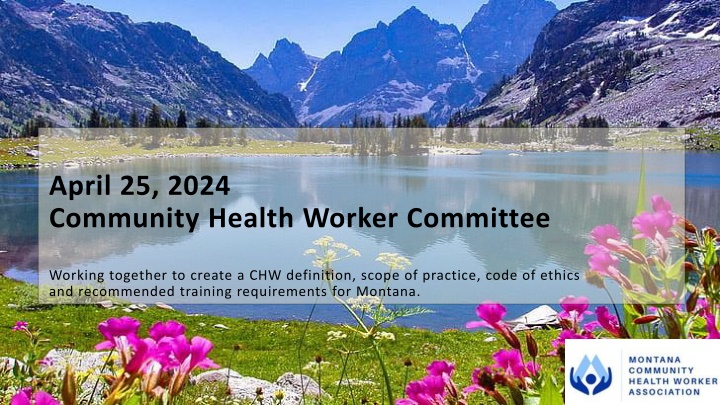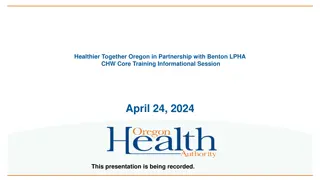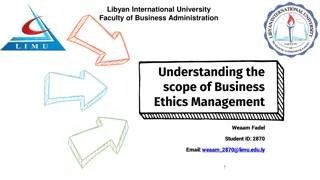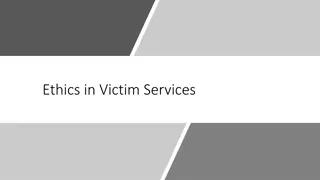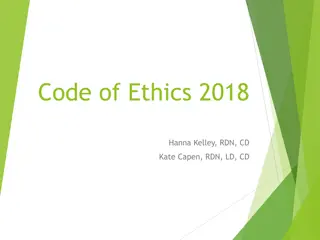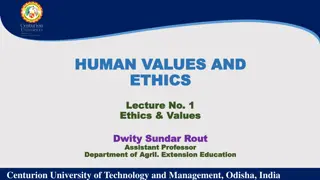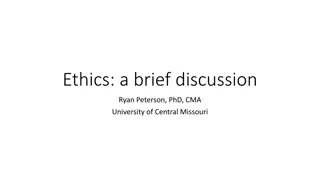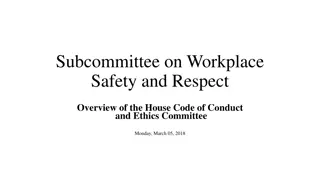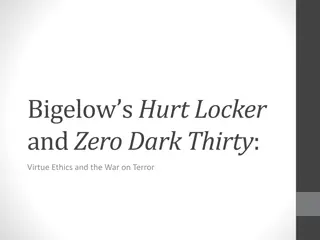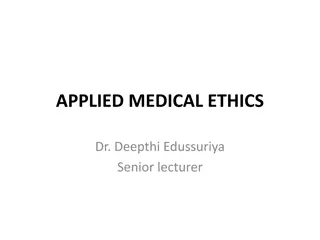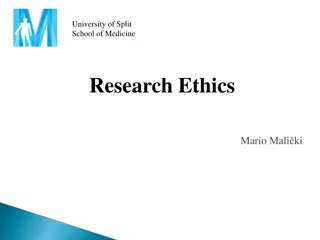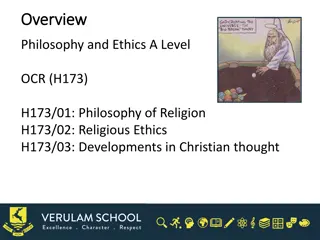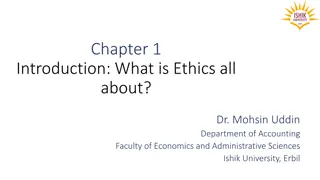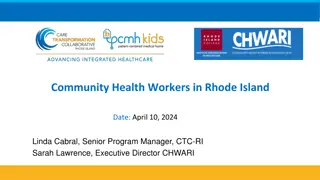Creating CHW Definition, Scope of Practice, and Code of Ethics
In April 25, 2024, the Community Health Worker Committee in Montana collaborated to establish a framework for CHWs, including definitions, scope of practice, and ethical guidelines. The committee worked on cultural mediation, health education, and information provision to enhance health literacy and promote culturally appropriate practices in healthcare settings.
Download Presentation

Please find below an Image/Link to download the presentation.
The content on the website is provided AS IS for your information and personal use only. It may not be sold, licensed, or shared on other websites without obtaining consent from the author.If you encounter any issues during the download, it is possible that the publisher has removed the file from their server.
You are allowed to download the files provided on this website for personal or commercial use, subject to the condition that they are used lawfully. All files are the property of their respective owners.
The content on the website is provided AS IS for your information and personal use only. It may not be sold, licensed, or shared on other websites without obtaining consent from the author.
E N D
Presentation Transcript
April 25, 2024 Community Health Worker Committee Working together to create a CHW definition, scope of practice, code of ethics and recommended training requirements for Montana.
Introductions Name Pronouns Organization & Job Title Where You're Located Ice Breaker: What's your favorite thing to do in your free time?
Ground Rules Ground Rules Approach the work with care, honesty, and empathy. Use each interaction to build community. Take responsibility for and respect the conversations you participate in. Respect the confidentiality and personal wishes of other members. Bring questions, concerns, or feedback to the meetings to be discussed. Reach out to Emma Simuns for support
Group Expectations Group Expectations Do your best to come prepared to the meeting, but know we'd rather you show up even if you don't have time to prepare If you miss a meeting, please try to read the minutes or watch the recording before the next meeting Read any uploaded resource materials before the meetings Be prepared to use your voice and make decisions
Role 1: Cultural mediation among individuals, communities, and health and social service systems Consensus Y/N Sub-Role 1: Educating individuals and communities about how to use health and social service systems (including understanding how systems operate) Notes: Building relationships and sharing information is critical Sub-Role 2: Educating systems about community perspectives and cultural norms (including supporting implementation of Culturally and Linguistically Appropriate Services [CLAS] standards) Notes: Ensure 'bridging the gap' to support network is part of this sub-role Building cross agency support to connect clients with multiple needs Sub-Role 3: Building health literacy and cross cultural communication
Roles 2: Providing culturally appropriate health education and information Consensus Y/N Sub-Role 1: Conducting health promotion and disease prevention education in a manner that matches linguistic and cultural needs of participants or community Sub-Role 2: Providing necessary information to understand and prevent diseases and to help people manage health conditions (including chronic disease)
Role 3: Care coordination, case management, and system navigation Consensus Y/N Sub-Role 1: Participating in care coordination and/or case management Sub-Role 2: Making referrals and providing follow-up Notes: Developing relationships to assist clients in supportive referrals Sub-Role 3: Facilitating transportation to service and helping address barriers to services Sub-Role 4: Documenting and tracking individual and population level data Sub-Role 5: Informing people and systems about community assets and challenges
Role 4: Providing coaching and social support Consensus Y/N Sub-Role 1: Providing individual support and coaching Sub-Role 2: Motivating and encouraging people to obtain care and other services Sub-Role 3: Supporting self-management of disease prevention and management of health conditions (including chronic disease) Sub-Role 4: Planning and/or leading support groups Notes: Are support groups within the 'lane' of CHWs?
Role 5: Advocating for individuals and communities Consensus Y/N Sub-Role 1: Advocating for the needs and perspectives of communities Notes: Advocating for basic needs and rights can sometimes get sticky legally speaking Empowering / educating client to advocate for themselves Sub-Role 2: Connecting to resources and advocating for basic needs (e.g. food and housing) Sub-Role 3: Conducting policy advocacy
Role 6: Building individual and community capacity Consensus Y/N Sub-Role 1: Building individual capacity Notes: Strengths-based perspective Sub-Role 2: Building community capacity Sub-Role 3: Training and building individual capacity with peers and among CHW groups
Role 7: Providing direct services Consensus Y/N Sub-Role 1: Providing basic screening tests (e.g. height, weight, blood pressure) Notes: Currently being done in MT by CIH at St. Peters in Townsend Sub-Role 2: Providing basic services (e.g. first aid, diabetic foot checks) Notes: What does first aid look like? Liability with first aid on the organization? Is diabetic foot checks another level of training? What is clinical and what is not? Currently being done in MT by CIH at St. Peters in Townsend Sub-Role 3: Meeting basic needs (e.g. direct provision of food and other resources)
Role 8: Implementing individual and community assessments Consensus Y/N Sub-Role 1: Participating in design, implementation, and interpretation of individual-level assessments (e.g. home environmental assessment) Notes: Love the word 'participation' and not just 'design' which implies a higher level of responsibility Depression and suicide screenings are implemented typically by behavioral health team, not CHWS Sub-Role 2: Participating in design, implementation, and interpretation of community-level assessments (e.g. windshield survey of community assets and challenges, community asset mapping)
Role 9: Conducting Outreach Consensus Y/N Sub-Role 1: Case-finding/recruitment of individuals, families, and community groups to services and systems Sub-Role 2: Follow-up on health and social service encounters with individuals, families, and community health groups Sub-Role 3: Home visiting to provide education, assessment, and social support Notes: Does home visiting belong here or somewhere else? Sub-Role 4: Presenting at local agencies and community events Notes: May not be a good fit for everyone Different verbiage need? Ex: replacing presenting with attending, tabling, engaging, or participating in
Role 10: Participating in evaluation and research Consensus Y/N Sub-Role 1: Engaging in evaluating CHW services and programs Sub-Role 2: Identifying and engaging community members as research partners, including community consent processes Sub-Role 3: Participating in evaluation and research a) Identification of priority issues and evaluation/research questions b) Development of evaluation/research design and methods c) Data collection and interpretation d) Sharing results and findings e) Engaging stakeholders to take action on findings
Definition Organization Community Health Workers (CHWs) are frontline public health workers who are trusted members of and /or have an unusually close understanding of the community served. This trusting relationship enables CHWs to serve as a liaison/link/intermediary between health/social services and the community to facilitate access to services and improve the quality and cultural competence of service delivery. CHWs also build individual and community capacity by increasing health knowledge and self-sufficiency through a range of activities such as outreach, community education, informal counseling, social support and advocacy. American Public Health Association A Community Health Worker (CHW) with or without compensation, is a liaison and provides cultural mediation between health care, social services, and the community. A promotor(a) or community health worker is a trusted member and has a close understanding of, the ethnicity, language, socio-economic status, and life experiences of the community served. A promotor(a) or community health worker assists people to gain access to needed services and builds individual, community, and system capacity. They help increase health knowledge and self- sufficiency through a range of activities such as outreach, patient navigation, and follow-up, community health education and information, informal counseling, social support, advocacy, and participation in clinical research. Texas Health and Human Services A trusted member of the community with a passion for helping others prevent or manage disease or other physical/behavioral health issues. They help bridge cultural, linguistic, knowledge and literacy differences among individuals, families, communities and providers. They help improve communications involving community members and agency or institutional professionals. CHWs understand and share information about available resources, and support planning and evaluation to improve health services. Pennsylvania AHEC
Definition Organization CHWs are frontline public health workers and critical members of health care delivery teams. They focus on the social aspects of care that support and enhance critical clinical activities such as diagnosis, treatment, or clinical procedures that are performed by licensed health professionals like doctors and nurses. These social and routine aspects of chronic care often are not prioritized in busy and resource-low clinical settings which can be managing high patient loads each day. This care is essential to assist families to adopt and maintain behavior change skills needed to manage their health, and to overcome barriers encountered in the health care system. New Mexico Department of Health A CHW/CHR is a non-physician, frontline public health worker who is a trusted member of and/or has an in-depth understanding of the community served, often because they are from those communities. This generally means they have deep connections with the vulnerable communities they serve, including experience-based knowledge on how to build individual and community capacity, how to effectively outreach and educate the community, and how to deliver culturally appropriate health education and information. A CHW/CHR serves as a liaison between health/social services and the community to facilitate access to services and improve the quality and cultural competence of service delivery, including the coordination of services to improve medical and behavioral health outcomes Arizona Medicaid
